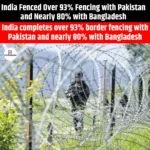Child marriage is declining rapidly in India
Child marriage cases are gradually decreasing in India. Just Rights for Children (JRC) presented its report, “Tipping Point to Zero: Evidence Towards a Child Marriage-Free India,” at a recent United Nations General Assembly event in New York, stating that child marriages among girls have declined by 69% and among boys by 72%.
This proves that the country is rapidly moving towards a child marriage-free India.
The survey used a multistage random sampling method from 757 villages across five states to capture India’s social and cultural diversity. Frontline workers such as ASHA workers, Anganwadi workers, school teachers, nurses, midwives, and Panchayat members were contacted to collect data.
Assam has the largest decline in child marriage:
Assam has recorded the largest decline in child marriage. Child marriages have declined by 84% for girls and 91% for boys over the past three years. Other states have also seen declines:
- Maharashtra and Bihar: 70% reduction
- Rajasthan: 66% reduction
- Karnataka: 55% reduction for girls, 88% reduction for boys
Reasons behind the decline in child marriage in Assam:
Assam’s success is attributed to the state government’s zero-tolerance approach, strict legal action, and coordinated efforts with the central government and civil society organizations. Public awareness of child marriage laws in the state is nearly universal (99%). Television (92%) and NGOs (76%) have been the main sources of this information.
Awareness has become the most powerful weapon:
Earlier, in 2019–21, three child marriages took place every minute in India, but only three complaints were filed daily. Now, the situation has changed, and almost everyone is aware of the laws related to child marriage.
- Bihar: 93%, Maharashtra: 89%, Assam: 88% received information through NGOs.
- Schools played a key role in spreading awareness in Rajasthan and Maharashtra, with 87% and 77% receiving information from schools, respectively.
Reasons for child marriage:
- 91% of respondents cited poverty.
- Protection of minor girls (44%).
- Traditions and social norms.
Disadvantages of early marriage:
- A girl’s education remains incomplete.
- She doesn’t get the opportunity to work or earn money.
- She is unable to contribute equally to society.
- There is a higher risk of domestic violence (assault).
- The risk of diseases like HIV/AIDS increases.
- Becoming a mother at a young age has adverse effects on health.
- Pregnancy and childbirth can even be life-threatening.
Education and Challenges:
- Only 31% of girls aged 6-18 years in the survey attend school, with disparities observed in Bihar (9%) and Maharashtra (51%).
- The main barriers to education are poverty (88%), lack of infrastructure (47%), safety concerns (42%), and lack of transportation (24%).
Status of Child Marriage in India:
- Approximately 73,501 child marriages were prevented in 2023-24.
- 59,364 with the help of Panchayats.
- 14,137 through legal action.
- More than 1.15 million children are at high risk of child marriage in 27 states and 7 union territories.
- The highest number is in Uttar Pradesh.
- In 2022, 3,563 child marriage cases were filed in courts, but only 181 cases were completed.
- Child marriage rates are gradually declining:
- 1990–2005: Declining by approximately 1% per year.
- In the last decade: Declining by approximately 2% per year.
Measures and Awareness:
- Arrests and FIRs are seen as the strongest deterrents to child marriage.
- This decline is attributed to coordinated action by the government and civil society organizations.
- 99% of respondents were aware of the Government of India’s Child Marriage Free India campaign.
- Awareness has reached almost universal levels, and there has been a significant increase in reporting cases of child marriage.
How much responsibility does society have?
- Parents, teachers, and youth must take the initiative.
- Every underage marriage must be protested and reported.
- Children must be given back their right to childhood.
How much can NGOs be involved?
NGOs play a vital role in preventing child marriage at the grassroots level. They act as a bridge between communities and the government through legal aid, warnings, awareness campaigns, and evidence-based counseling. Through this, parents, teachers, youth, and other community members learn why early marriage is wrong and what steps can be taken to prevent it.
Initiatives to End Child Marriage in India:
- The Prohibition of Child Marriage Act (PCMA), 2006: Prohibits the marriage of girls under 18 years of age and boys under 21 years of age.
- National Action Plan: Supports girls at risk of child marriage.
- Child Marriage Free India Campaign: Advocates for legal changes to maintain the minimum age of marriage at 18 years and ensure legal protection.
Globally, the UNFPA-UNICEF Global Programme to End Child Marriage (GPECM), launched in March 2016, promotes the rights of adolescent girls and works to prevent child marriage, early marriage, and forced marriage.
Way Forward:
The report offers several recommendations to eliminate child marriage by 2030:
- Strict enforcement of child marriage laws.
- Strengthening information systems.
- Making marriage registration mandatory.
- Running awareness programs at the village level.
- Declaring a national day for a child marriage-free India.
Global Child Marriage Statistics:
- Approximately 12 million girls are married every year.
- The highest rates of child marriage occur in South Asia and Sub-Saharan Africa.
- Approximately 120 million girls under the age of 18 are already married worldwide.
Conclusion:
Child marriage rates in India are gradually decreasing, demonstrating that awareness, legislation, and community efforts are rapidly progressing towards a child marriage-free India.










